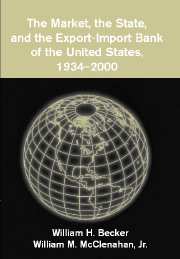Book contents
- Frontmatter
- Contents
- Preface and Acknowledgments
- Introduction
- 1 Setting a Flexible Course: The Export-Import Bank, 1934–1939
- 2 World War and Its Aftermath
- 3 Cold War and the Needs of a New Era, 1948–1961
- 4 Becoming “Two Institutions”
- 5 New Mandates and New Limits
- 6 Turmoil and Turning Points
- 7 A New Era and Its Challenges, the 1990s
- Epilogue
- Appendix A Board of Directors
- Appendix B Summary of Authorizations
- Appendix C Number of Authorizations
- Appendix D Charges Against Statutory Limitations on Total Activity
- Index
4 - Becoming “Two Institutions”
Published online by Cambridge University Press: 13 July 2009
- Frontmatter
- Contents
- Preface and Acknowledgments
- Introduction
- 1 Setting a Flexible Course: The Export-Import Bank, 1934–1939
- 2 World War and Its Aftermath
- 3 Cold War and the Needs of a New Era, 1948–1961
- 4 Becoming “Two Institutions”
- 5 New Mandates and New Limits
- 6 Turmoil and Turning Points
- 7 A New Era and Its Challenges, the 1990s
- Epilogue
- Appendix A Board of Directors
- Appendix B Summary of Authorizations
- Appendix C Number of Authorizations
- Appendix D Charges Against Statutory Limitations on Total Activity
- Index
Summary
INTRODUCTION
John F. Kennedy promised to get America moving again in the 1960 presidential election campaign. Despite the youthful energy that Kennedy brought to the White House, problems and issues that had surfaced during the Eisenhower years carried over into the new administration, and that of Lyndon B. Johnson and later Richard M. Nixon. America's balance of payments position continued to erode. Pressures on the federal budget persisted from one administration to the other. And the Cold War became more contentious, especially during the Kennedy years, as an activist administration in the United States faced an opportunistic leadership in the USSR.
These circumstances shaped the Bank's experience in the Kennedy–Johnson, and the first Nixon, administration. Under the leadership of Harold F. Linder (March 1961–July 1968), the Export-Import Bank assiduously followed its established policies of risk assessment and loan management. But the way in which Ex-Im employed its assets changed as the Bank increasingly made use of guarantees and insurance. Indeed, the Bank's 1965 annual report said that it had become two institutions, one focused on direct lending, the other on guarantees and insurance. During the Kennedy and Johnson administrations, the geographic focus of Bank long-term credits shifted away from development projects in Latin America. It also became an important supplier of credits for purchases of the products of the jet aircraft, nuclear power, and new earth satellite industries.
- Type
- Chapter
- Information
- Publisher: Cambridge University PressPrint publication year: 2003

